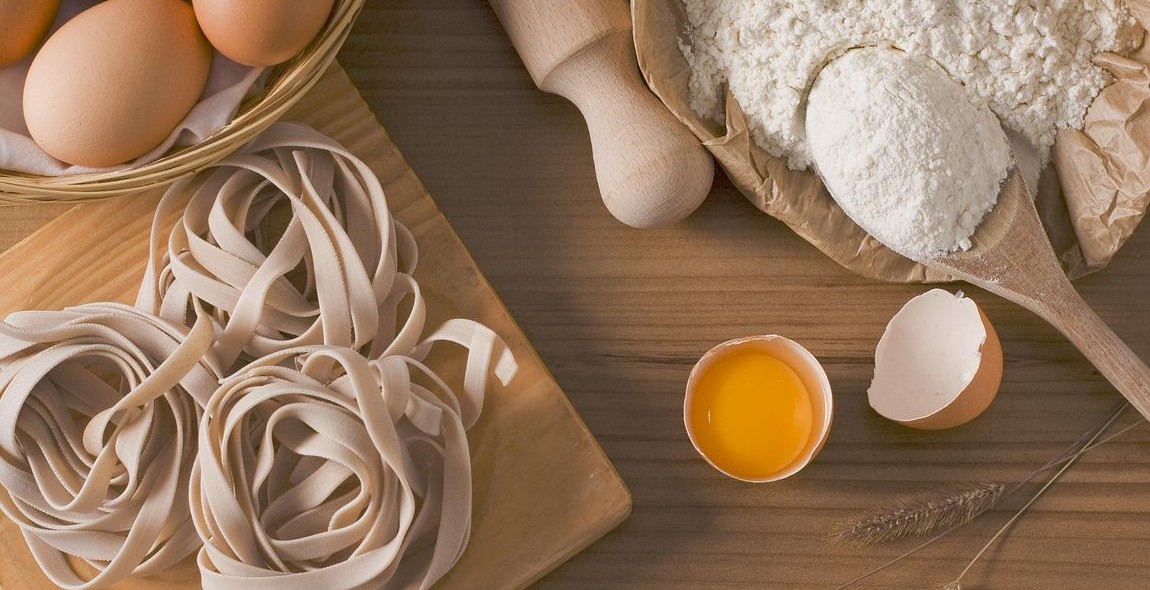How to Make Your Own Fresh Pasta from Scratch
If you’re a pasta lover, you know that nothing beats the taste and texture of fresh, homemade pasta. Making your own pasta may seem intimidating at first, but it’s actually a simple process that anyone can do with the right tools and a little bit of practice.
Why Make Your Own Pasta?
While store-bought pasta is convenient and readily available, it often lacks the flavor and texture of fresh pasta. By making your own pasta, you can customize it to your liking, experiment with different flours and ingredients, and ensure that it’s free from any additives or preservatives.
What You’ll Need
Before you get started, you’ll need a few basic tools:
- A pasta maker or rolling pin
- All-purpose flour or semolina flour
- Eggs
- Water
- A mixing bowl and fork
Once you have your tools and ingredients, you’re ready to start making your own fresh pasta from scratch. Follow our step-by-step guide for the perfect homemade pasta every time.
Ingredients for Fresh Pasta Dough
Before you start making your own fresh pasta, you need to gather the right ingredients. Here are the four essential ingredients you will need to make your own fresh pasta dough:
| Ingredients | Quantity |
|---|---|
| Flour | 2 cups |
| Eggs | 3 large |
| Salt | 1/2 tsp |
Pasta Dough
The pasta dough is the foundation of any good pasta dish, and it all starts with the right flour. You will need to use a high-quality all-purpose flour or Italian 00 flour. The flour will give your pasta dough structure and texture, so it’s important to choose the right one.
Flour
The most important ingredient in fresh pasta dough is flour. As mentioned, you can use either all-purpose flour or Italian 00 flour. The flour should be sifted before use to remove any lumps and to ensure that it is evenly mixed with the other ingredients.
Eggs
Eggs are another essential ingredient in fresh pasta dough. They provide moisture, richness, and help bind the dough together. It is important to use fresh, large eggs at room temperature for the best results.
Salt
Salt is used to enhance the flavor of the pasta dough. It is important to use the right amount of salt, as too much can make the dough tough, while too little can make it bland.
With these four ingredients, you are ready to start making your own fresh pasta dough from scratch.

Equipment for Making Fresh Pasta
Before you start making your own fresh pasta from scratch, you will need some basic equipment to ensure the process goes smoothly. Here are the essential tools you will need:
Mixing Bowl
A mixing bowl is an essential tool for making fresh pasta dough. You will need a large mixing bowl to combine your flour and eggs and mix them until they form a smooth, elastic dough. A stainless steel mixing bowl is a great option, as it is sturdy and easy to clean. You can also use a plastic or glass mixing bowl if that’s what you have on hand.
Fork or Whisk
You will need a fork or whisk to beat your eggs before adding them to your flour. Beating your eggs before adding them to the flour will ensure that they are evenly distributed throughout the dough. A fork or whisk will also help you mix the eggs and flour together until they form a smooth dough.
Rolling Pin
A rolling pin is an essential tool for rolling out your pasta dough. You can use a traditional wooden rolling pin or a modern silicone rolling pin. A rolling pin with handles on both ends will make it easier to roll out your dough evenly. You can also use a pasta machine to roll out your dough if you have one.
Knife or Pasta Cutter
You will need a knife or pasta cutter to cut your pasta dough into the desired shape. A sharp chef’s knife or a pasta cutter with a sharp blade will make it easier to cut your dough into noodles or other shapes. You can also use a pizza cutter or a pair of scissors if that’s what you have on hand.
Having the right equipment is essential for making fresh pasta from scratch. With these basic tools, you can easily make delicious homemade pasta that will impress your family and friends.

Making the Dough
Making fresh pasta from scratch is a simple process that requires only a few basic ingredients and some elbow grease. The key to making great pasta is in the dough, and there are three essential steps to creating the perfect dough: mixing, kneading, and resting.
Step 1: Mixing the Ingredients
The first step in making fresh pasta is to mix the ingredients. The basic ingredients for pasta dough are flour, eggs, salt, and water. You can use all-purpose flour or semolina flour, or a combination of both. The ratio of flour to eggs is typically one egg per 100 grams of flour.
To mix the ingredients, pour the flour onto a clean work surface and make a well in the center. Crack the eggs into the well and add a pinch of salt. Using a fork, beat the eggs and gradually incorporate the flour until a dough forms. If the dough is too dry, add a tablespoon of water at a time until it comes together.
Step 2: Kneading the Dough
Once the dough has come together, it’s time to knead it. Kneading helps to develop the gluten in the dough, which gives it its elasticity and chewiness. To knead the dough, dust your work surface with flour and begin to knead the dough with the heel of your hand. Fold the dough in half and repeat, adding more flour as needed to prevent sticking. Knead the dough for about 10 minutes, or until it’s smooth and elastic.
Step 3: Resting the Dough
After kneading, the dough needs to rest for at least 30 minutes. This allows the gluten to relax and makes the dough easier to roll out. To rest the dough, wrap it in plastic wrap and let it sit at room temperature. You can also refrigerate the dough for up to 24 hours, which will give it even more flavor.
Now that you’ve made the dough, you’re ready to roll it out and cut it into your desired shape. Whether you’re making fettuccine, spaghetti, or ravioli, the key to great pasta is in the dough. By following these simple steps, you’ll be well on your way to making delicious fresh pasta from scratch.

Rolling and Cutting the Pasta
After dividing the dough, the next step in making fresh pasta is rolling and cutting the pasta. Here’s how to do it:
Step 1: Rolling the Pasta
Before rolling the pasta, dust your work surface with flour to prevent sticking. Take one of the dough balls and flatten it slightly with your hands. Then, using a rolling pin, roll the dough out into a thin sheet. You can roll the pasta to your desired thickness, but a thickness of around 1/8 inch is recommended.
As you roll the pasta, you may need to dust it with flour to prevent sticking. Once you have rolled the pasta to your desired thickness, let it rest for a few minutes before cutting it.
Step 2: Cutting the Pasta
Once the pasta has rested, it’s time to cut it into the desired shape. There are many different shapes you can make, including fettuccine, linguine, and spaghetti. Here’s how to cut the pasta:
- Using a sharp knife or a pasta cutter, cut the pasta sheet into strips of your desired width. For fettuccine, cut the pasta into strips that are about 1/4 inch wide. For linguine, cut the pasta into strips that are about 1/8 inch wide.
- Once you have cut the pasta into strips, dust them with flour to prevent sticking.
- If you are not cooking the pasta immediately, you can hang it on a pasta drying rack to dry. This will prevent the pasta from sticking together.
Alternatively, you can use a pasta machine to roll and cut the pasta. Simply feed the pasta sheet through the machine, adjusting the thickness as desired, and then use the cutting attachment to cut the pasta into your desired shape.
With these simple steps, you can roll and cut your own fresh pasta at home. Whether you prefer fettuccine, linguine, or spaghetti, making your own pasta is a fun and rewarding experience that will impress your family and friends.

Cooking and Serving the Pasta
Now that you have made your own fresh pasta from scratch, it’s time to cook and serve it. Here are the steps to follow:
Step 1: Boiling the Water
Fill a large pot with water and add a generous amount of salt. Bring the water to a rolling boil over high heat. The general rule of thumb is to use 4-6 quarts of water per pound of pasta.
Step 2: Cooking the Pasta
Once the water is boiling, add the fresh pasta. Stir occasionally to prevent it from sticking together. Fresh pasta will cook much faster than dried pasta, so keep an eye on it. It should only take 1-3 minutes to cook, depending on the thickness of the pasta.
To check if the pasta is cooked, taste a piece. It should be al dente, which means it should be cooked but still firm to the bite. Once the pasta is cooked, remove it from the pot using a slotted spoon or pasta fork.
Step 3: Serving the Pasta
There are many ways to serve fresh pasta. Here are a few ideas:
- Top with your favorite sauce, such as marinara, alfredo, or pesto.
- Toss with olive oil, garlic, and Parmesan cheese.
- Add sautéed vegetables, such as mushrooms, zucchini, or bell peppers.
- Serve with grilled chicken, shrimp, or steak.
Once you have chosen your toppings, use tongs to mix the pasta and sauce together. Divide the pasta into individual serving bowls and garnish with fresh herbs or additional Parmesan cheese.
Enjoy your delicious homemade pasta!
